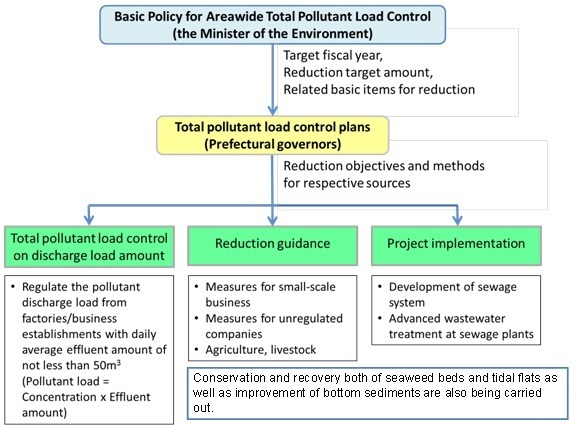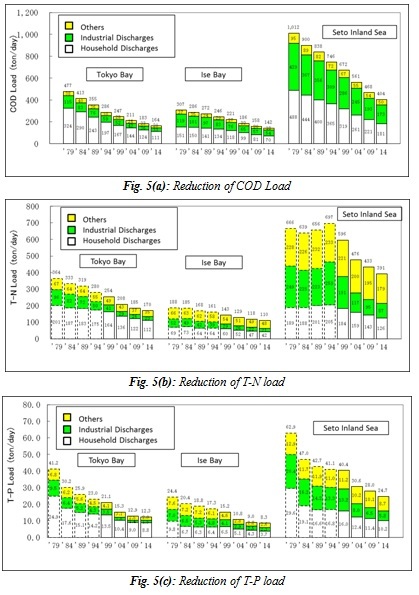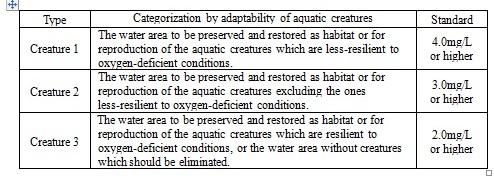BISAC NAT010000 Ecology
BISAC NAT045050 Ecosystems & Habitats / Coastal Regions & Shorelines
BISAC NAT025000 Ecosystems & Habitats / Oceans & Seas
BISAC NAT045030 Ecosystems & Habitats / Polar Regions
BISAC SCI081000 Earth Sciences / Hydrology
BISAC SCI092000 Global Warming & Climate Change
BISAC SCI020000 Life Sciences / Ecology
BISAC SCI039000 Life Sciences / Marine Biology
BISAC SOC053000 Regional Studies
BISAC TEC060000 Marine & Naval
Japan experienced serious water pollution during the period of high economic growth in 1960s. It was also the period that we had such damages to human health, fishery and living conditions due to red tide as much of chemicals, organic materials and the like flowing into the seas along the growing population and industries in the coastal areas. Notable in those days was the issues of environment conservation in the enclosed coastal seas where pollutants were prone to accumulate inside due to low level of water circulation, resulting in the issues including red tide and oxygen-deficient water mass. In responding to these issues, we implemented countermeasures like effluent control with the Water Pollution Control Law and improvement/expansion of sewage facilities. In the extensive enclosed coastal seas of Tokyo Bay, Ise Bay and the Seto Inland Sea, the three areas of high concentration of population, we implemented water quality total reduction in seven terms from 1979, reducing the total quantities of pollutant load of COD, TN and TP. Sea water quality hence has been on an improvement trend as a whole along the steady reduction of pollutants from the land. We however recognize that there are differences in improvement by sea area such as red tide and oxygen-deficient water mass continue to occur in some areas. Meanwhile, it has been pointed out that bio-diversity and bio-productivity should be secured through conservation/creation of tidal flats and seaweed beds in the view point of “Bountiful Sea” To work at these challenges, through the studies depending on the circumstances of the water environment in the enclosed coastal seas, we composed “The Policy of Desirable State of 8th TPLCS” in 2015. We have also added the sediment DO into the water quality standard related to the life-environmental items in view of the preservation of aquatic creatures in the enclosed water areas. Important from now on, along the Policy, is to proceed with necessary measures to improve water quality with good considerations of differences by area in the view point of “Beautiful and bountiful Sea”.
Total Pollutant Load Control System(TPLCS), Oxygen deficient water mass, Water quality, Bio-diversity, Bio-productivity
In the 1960s, Japan attained a yearly average economic growth rate of 9%, but in that process Japan could not deal with the significant increase of environmental pollutant load, and allowed air and water pollution to take place, which led to serious environmental pollution problems, including the degradation of living conditions, fishery damage, and health hazards. For this reason, it became necessary to improve the legal system and to establish an implementation structure for containing environmental pollution, to promote pollution control efforts by businesses and others organizations, to construct sewage systems, and to increase public awareness.
We will introduce in this paper our basic thoughts behind the countermeasures for the enclosed coastal seas in Japan to date as well as new policy directions, with putting a focus on the Total Pollutant Load Control System (TPLCS).
.jpg)
- Economic development and occurrence of serious water pollution problems
In Japan, industrial production began to increase from the late 1950s and the economy grew rapidly. Economic growth rate reached a yearly average of 9.1% from 1956 to 1973, and industrial production grew to approximately threefold in terms of the (price-adjusted) value of shipments from 1960 to 1975.
.jpg)
This rapid increase caused an increase in industrial production and population concentration, which entailed a considerable increase of pollutant load beyond any countermeasures, leading to serious water pollution that further caused damage to fishery by red tide and deterioration of living environment with foul-smelling drinking water and an offensive odor. In particular, the Seto Inland Sea was even called “The Dying Sea,” because of severe water pollution, particularly with red tide causing fishery damages.
- Overview of the TPLCS in Japan
Faced with escalating environmental pollution, however, citizens called for countermeasures against the pollution. Gathering momentum for the movement, the public urged the legal system to be upgraded rapidly from around 1970, and intensive countermeasures were implemented. In 1978, the Water pollution Control Law and the Interim Law for Conservation of the Environment of the Seto Inland Sea were partially amended, and the TPLCS was introduced. The TPLCS aimed to reduce industrial effluent and all other inflowing pollutant loads including domestic wastewater. At first, the target item of the TPLCS was limited to COD, but in 2001 it was expanded to include total nitrogen and total phosphorus, which can cause eutrophication.

Fig. 3: Target area of the TPLCS (Tokyo Bay, Ise Bay and Seto Inland Sea)
Overview of the TPLCS in Japan is as follows:
- Total pollutant load control was implemented in enclosed seas, broad public waters where effluents from domestic and business activities due to population and industrial concentration flow in in great amount, if it was difficult to meet the Environmental Quality Standards for Water pollution by effluent control alone (targeted areas were specified in Tokyo Bay and Ise Bay, and the Seto Inland Sea).
- The reduction objective for the target fiscal year was established by calculating the total pollutant load for each source in industrial, domestic, and other sectors (agriculture, livestock, forest, built-up areas, and aquaculture).
- The reduction objective was the amount that was aimed to be reduced as far as practicable in consideration of the trend of population and industry, the treatment level of wastewater or waste liquid, and outlook for the construction of sewage systems.
- When implementing the TPLCS, the Minister of the Environment formulated the TPLCS Policy which specified the reduction objective for each prefecture (including the capital city). Based on this, each Prefectural Governor formulated a total pollutant load control plan that contained the reduction objectives for each source and methods of attaining the objectives.
The prefectures (including the capital city) formulated their own business-category-based Total Pollutant Load Control Standards for factories and business establishments to be regulated, on the basis of their own total pollutant load control plans, within the range specified by the Minister of the Environment

Fig. 4: Schematic structure of the TPLCS in Japan
The results out of countermeasures including the TPLCS
The TPLCS has set reduction targets almost every five years since 1979. In the 7th plan to FY2014, the TPLCS carried out the planned measures for a gradual and continued reduction of the pollutant loads.
As shown in Fig. 5, the COD, TN, and TP loads in Tokyo Bay, Ise Bay, and the Seto Inland Sea have been steadily reduced.

As shown in Fig. 6, the annual red tide occurrences in the Seto Inland Sea was about 300 cases around 1975 but it decreased to around 100 cases in the late 1980s, and this level has remained to date. We meanwhile still continue to see around 50 cases a year of red tide each in Tokyo Bay and Ise Bay.
.jpg)
| Fig. 6: Occurrences of red tide in Tokyo Bay, Ise Bay and the Seto Inland Sea |
- Future administrative direction for the enclosed coastal seas (The Policy of Desirable State of 8th TPLCS)
Our administrative measures including TPLCS realized a stable decrease in volume of pollutant loads from the land. We yet recognize the different circumstances of COD, nitrogen and phosphorus by sea area while continue to observe red tides and oxygen deficient water mass to date. It has been also pointed out, in view of “Bountiful Sea”, the importance of securing bio-diversity and bio-productivity through conservation and restoration of seaweed bed and tidal flat. Under these circumstances, MOE has been working at the implementation of the next or the 8th TPLCS in order to proceed with the comprehensive countermeasures to improve water environment.
Depending on the circumstances and the current challenges, the Central Council for the Environment which was composed with the knowledgeable persons examined “The Policy of Desirable State of 8th TPLCS” and came up with their report in December 2015. The outline of their report is as follows.
Necessity to improve water quality in the designated water areas
- Tokyo Bay and Ise Bay
Need to continue to work at the management to improve water environment.
- Osaka Bay
Need to proceed with the countermeasures to improve water environment with thinking of achievement level of environment standards for nitrogen and phosphorus.
- The Seto Inland Sea excluding Osaka Bay
Appropriate is to take necessary countermeasures lest water quality is deteriorated.
Expected countermeasures
Emphasizing the need to promote an overall countermeasures to improve water environment in view point of “Beautiful and bountiful sea,” a set of measures was outlined for pollutant load reduction including conservation and restoration of seaweed bed and tidal flat.
- Measures for pollutant load reduction
- Tokyo Bay, Ise Bay and Osaka Bay
Need to proceed with countermeasures to efficiently reduce pollutant loads. In Osaka Bay, specific measures to eliminate organic pollutants should be taken, observing the achievement level of environmental standards for nitrogen and phosphorus.
- the Seto Inland Sea excluding Osaka Bay
In view of the importance to secure bio-diversity and bio-productivity, need to proceed with the measures of precise water quality management by region and seasonality, the measures which should be adaptable against consequences and feasibility.
- Conservation and restoration of seaweed bed and tidal flat and improvement of the sediment conditions
In view of the importance to secure water quality purification , bio-diversity and bio-productivity through preservation and restoration of seaweed bed and tidal flat, the following priorities have been laid out on the thought that important is to carry out comprehensive measures reflecting the actual situation in respective regions.
- To promote restoration and creation of seaweed bed and tidal flat.
- To promote stable fishery of aquatic creatures through cultivation of no-feeding seaweeds and shellfish along management of catch and so forth.
- To improve sediment by dredging and sand-covering as well as sand-filling into the sand-digging depression.
- To facilitate the adoption of environment-friendly structures like bio-coexistence seawall in building of new seawall and maintenance and renovation of the existing seawall.
- To work in a comprehensive manner through coordination among a variety of local people from including related administrative organizations of the nation and the prefectures, NPOs, fishery, business.
- To support the people including NPOs, fishery and business, having their activities effectively promoted.
- Introduction of new water quality standard related to the life-environmental items
The background of the introduction of the new water quality standard
The environmental standard of water quality pollution, depending on the Environmental Basic Law, is set as the desirable criteria protecting health of people and preserving satisfactory level of living environment. Regarding the life-environment items, 12 items have been designated including COD, TN and TP. The environmental standard of COD, TN and TP has greatly and positively contributed to improve water quality since they have been set as the indices of organic pollutants and nutrients causing eutrophication.
Meanwhile, there are still such issues as oxygen-deficient water mass and decrease in seaweed bed and tidal flat. It is therefore pointed out that we need to have some new indices in addition to COD, TN and TP which are capable to basically evaluate the effectiveness of our countermeasures opposite the water pollution. In this regard, we have added in March 2016, based upon the report by the Central Environment Council, a new item of sediment DO into the life-environment items in view of the preservation of aquatic creatures including fish and shellfish.
Target value and future direction
The deterioration of sediment DO can directly result in harmful influence in habitat of aquatic creatures like fish and shellfish while it also negatively affect our life environment through such event of blue tide. We therefore set the target values as shown in Table.1 in three viewpoints of ; firstly, to secure habitat for aquatic creatures, secondly, to secure the place for aquatic creatures to reproduce, and finally, to eliminate the areas without creatures.
From now on, in order to improve sediment DO, we need to work at a package of countermeasures including the basic activities for water quality pollution, creation of seaweed bed and tidal flat, adoption of environment-friendly port structures, refilling of sand-digging depression in coordination among related people/organization where such coordination appears appropriate and necessary. Keeping in mind the desirable status in future, it is critical for us to proceed with comprehensive countermeasures also viewing over mid to long term initiatives for water environment preservation.
Table.1: Categorization and standard for sediment DO

- Conclusion
In the report on the Policy of Desirable State of 8th TPLCS, emphasized were preservation of good water quality and the importance to secure bio-diversity/bio-productivity. Besides, sediment DO was established as water quality standard related to the life-environmental items in view of the preservation of aquatic creatures.
We understand that scientific evaluation of circumstances is critical along the investigation and research in multi perspectives opposite nutrients, plankton, aquatic creatures, and climate change in addition to the long-continued water quality monitoring. We will carry out comprehensive and holistic measures for the enclosed seas through corporation with the related people including ministries/agencies, local prefectures, researchers, fishery, NPOs, business arena.
1. Central Environmental Council (2015), “第8次水質総量削減の在り方について” , Central Environmental Council, Japan (in Japanese)
2. Ministry of the Environment, Japan (2011), “Guidance for Introducing the Total Pollutant Load Control System (TPLCS)”, Ministry of the Environment, Japan, http://www.env.go.jp/en/water/ecs/pdf/english.pdf







